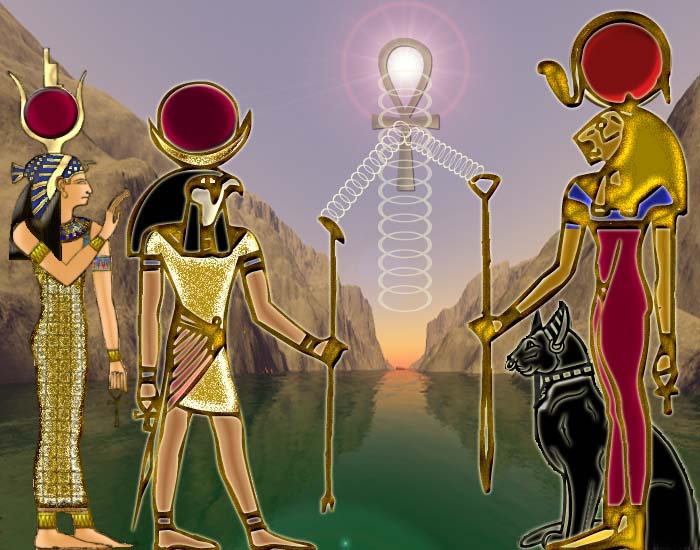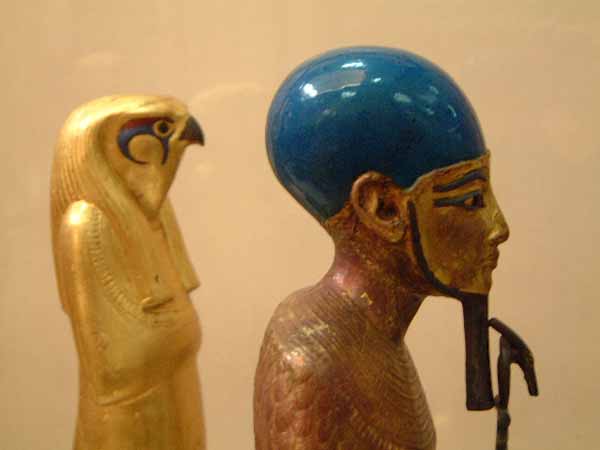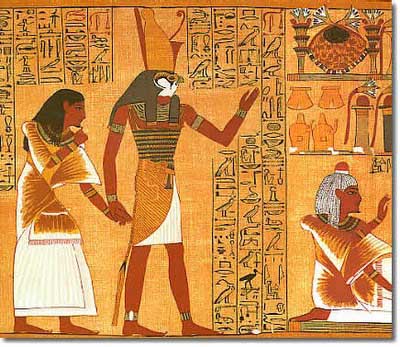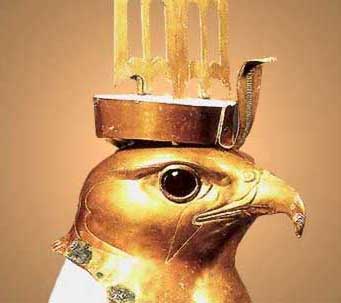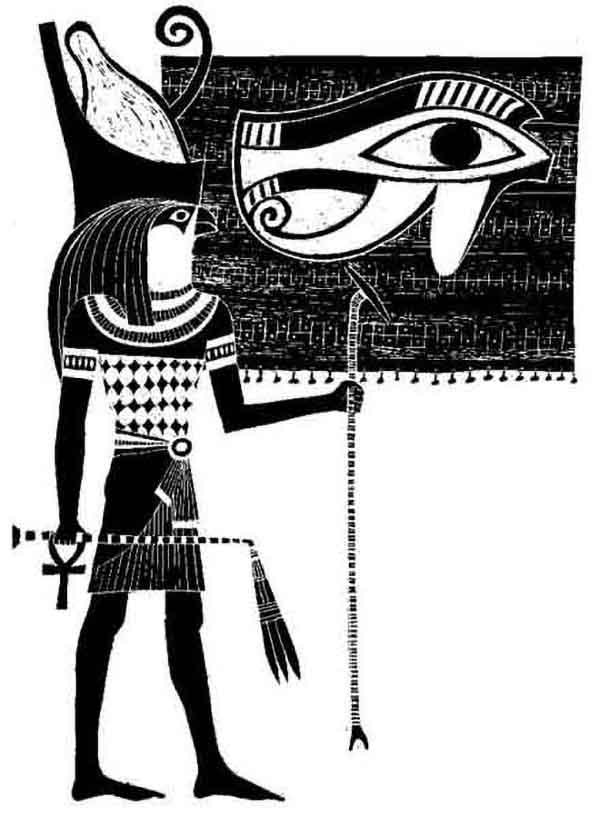
The falcon-headed Sky God

The falcon-headed Sky God
Horus is the god of the sky, and the son of Osiris, the creator (whose own birth was thought due to the Ogdoad). Horus became depicted as a falcon, or as a falcon-headed man, leading to Horus' name, (in Egyptian, Heru), which meant The distant one.
Horus was sometimes known as Nekheny (meaning falcon), although it has been proposed that Nekheny may have been another falcon-god, worshipped at Nekhen (city of the hawk), that became identified as Horus very early on. In this form, he was sometimes given the title Kemwer, meaning (the) great black (one), referring to the bird's color.
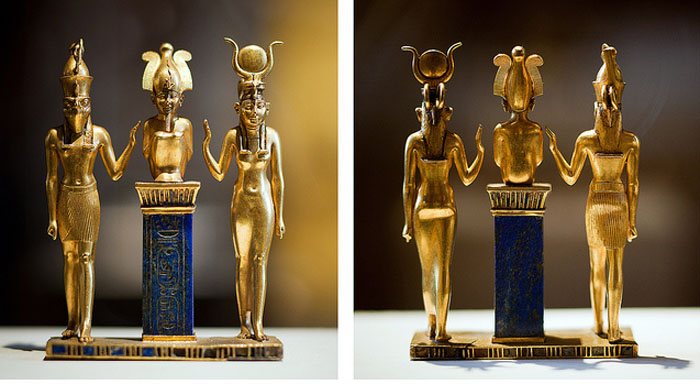
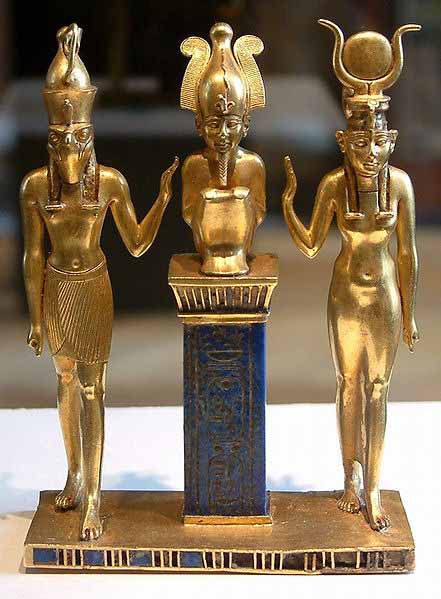
The family of Osiris. Osiris on a lapis lazuli pillar in the middle,
flanked by Horus on the left and Isis on the right (Louvre, Paris)
This myth has been told in various ways, but the message is aways the same - death and resurrection a metaphor for the journey of the soul in the alchemy of time.
Plutarch recounts one version of the myth surrounding the cult in which Set fooled Osiris into getting into a box, which he then shut, had sealed with lead, and threw into the Nile (sarcophagi were based on the box in this myth).
Osiris' wife, Isis, searched for his remains until she finally found him embedded in a tree trunk, which was holding up the roof of a palace in Byblos on the Phoenician coast. She managed to remove the coffin and open it, but Osiris was already dead. She used a spell she had learned from her father and brought him back to life so he could impregnate her. After they finished, he died again, so she hid his body in the desert.
Months later, she gave birth to Horus. While she was off raising him, Set had been out hunting one night, and he came across the body of Osiris. Enraged, he tore the body into fourteen pieces and scattered them throughout the land. Isis gathered up all the parts of the body, less the phallus which was eaten by a fish thereafter considered taboo by the Egyptians, and bandaged them together for a proper burial. The gods were impressed by the devotion of Isis and thus resurrected Osiris as the god of the underworld. Because of his death and resurrection, Osiris is associated with the flooding and retreating of the Nile and thus with the crops along the Nile valley.
Diodorus Siculus gives another version of the myth in which Osiris is described as an ancient king who taught the Egyptians the arts of civilization, including agriculture. Osiris is murdered by his evil brother Set, whom Diodorus associates with the evil Typhon ("Typhonian Beast") of Greek mythology. Typhon divides the body into twenty six pieces which he distributes amongst his fellow conspirators in order to implicate them in the murder. Isis and Horus avenge the death of Osiris and slay Typhon. Isis recovers all the parts of Osiris body, less the phallus, and secretly buries them. She made replicas of them and distributed them to several locations which then became centres of Osiris worship.
The tale of Osiris becoming fish-like is cognate with the story the Greek shepherd god Pan becoming fish like from the waist down in the same river Nile after being attacked by Typhon . This attack was part of a generational feud in which both Zeus and Dionysus were dismembered by Typhon, in a similar manner as Osiris was by Set in Egypt.
Osiris was viewed as the one who died to save the many, who rose from the dead, the first of a long line that has significantly affected man's view of the world and expectations of an afterlife.
Scholars such as E.A. Wallis Budge have suggested possible connections or parallels of Osiris' resurrection story with those found in Christianity: "The Egyptians of every period in which they are known to us believed that Osiris was of divine origin, that he suffered death and mutilation at the hands of the powers of evil, that after a great struggle with these powers he rose again, that he became henceforth the king of the underworld and judge of the dead, and that because he had conquered death the righteous also might conquer death. In "Osiris the Christian", Egyptians found the prototype of Christ, and in the pictures and statues of Isis suckling her son Horus, they perceived the prototypes of the Virgin Mary and her child."
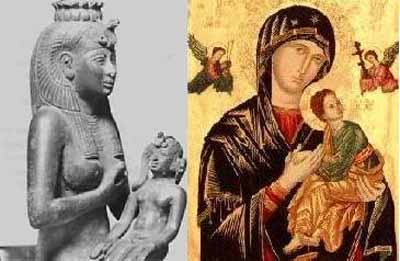
UFOs in Art History
- Mekhenti-irry (He who has on his brow Two Eyes) - the sun and moon representing his eyes, on nights when there is no moon. In this form he was considered the god of the blind.
- Haroeris (Horus the Elder) An early form of Horus - God of light. His eyes represented the sun and moon. He was the brother of Osiris and Seth. Sometimes he was the son, or the husband of Hathor.
- Horus Behudety In the form of Horus of Edfu, he represented the midday sun. This Horus was worshipped in the western Delta and later, as his cult spread south into Upper Egypt, a cult center was established in Edfu. Horus of Edfu fights a great battle against Seth and an army of conspirators. He is pictured as a winged sun-disk or as a hawk headed lion.
- Ra-Harakhte (Horus of the two horizons) - He was identified with Ra and the daily voyage of the sun from horizon to horizon. The two deities combined to become Ra-Harakhte. He was represented as a falcon or a falcon-headed man wearing the solar disk and double crown or the uraeus and the atef crown.
- Harmakhet (Horus in the Horizon) In this form he represented the rising sun and was associated with Khepri. He was also considered to be the keeper of wisdom. He was sometimes pictured as a man with a falcon's head, or a falcon headed lion. But his most recognizable form is that of a sphinx, or as a ram-headed sphinx.
- Harsiesis (Horus son of Isis) This Horus was the son of Isis and Osiris. He was conceived magically after the death of Osiris and brought up by Isis on a floating island in the marshes of Buto. The child was weak and in constant danger from the scheming of his wicked uncle Seth, who sent serpents andmonsters to attack him. But his mother, Isis was great in themagical arts and she warded off this evil by using a spellagainst creatures biting with their mouths and stinging withtheir tails, and the young Horus survived and grew.
- Harendotes (Horus the avenger of his father)
- Har-pa-Neb-Taui (Horus Lord of the Two Lands)
- Harpokrates (The infant Horus) As a child he represented the new born sun and was often pictured being suckled by Isis. he was usually represented as a seated child, sucking his thumb, his head was shaved except for the sidelock of youth. Even as a child, he wore the royal crown and uraeus
As Horus was the son of Osiris, and god of the sky, he became closely associated with the Pharaoh of Upper Egypt (where Horus was worshipped), and became their patron. The association with the Pharaoh brought with it the idea that he was the son of Isis, in her original form, who was regarded as a deification of the Queen.
It was said that after the world was created, Horus landed on a perch, known as the djeba, which literally translates as finger, in order to rest, which consequently became considered sacred. On some occasions, Horus was referred to as lord of the djeba (i.e. lord of the perch or lord of the finger), a form in which he was especially worshipped at Buto, known as Djebauti, meaning (ones) of the djeba (the reason for the plural is not understood, and may just have been a result of Epenthesis, or Paragoge). The form of Djebauti eventually became depicted as an heron, nevertheless continuing to rest on the sacred perch.
Just as a precaution: a great deal of the following information is incorrect. For example, Isis has always been Horus' mother and never his wife. Osiris has always been Horus' father and Horus is not both Horus and Osiris. The relation between the story of Jesus and the story of Horus is the fact that Horus' story is the story of the REAL first immaculate conception.
The story goes as follows: Seth (brother of Osiris) was jealous of Osiris and fought him to the death. After he killed Osiris he cut his body up into 14 pieces and spread the pieces throughout Egypt. Isis (Osiris' wife) found out that her husband was killed and she searched egypt looking for his body parts. She found all but one (his penis) and using her magic she put his body together and buried him, during the process of putting him back together she became impregnated with her son Horus. She gave birth to Horus who became the god of the sky and later avenged his fathers death by killing his uncle Seth.
Since Horus was said to be the sky, it was natural that he was rapidly considered to also contain the sun and moon. It became said that the sun was one of his eyes and the moon the other, and that they traversed the sky when he, a falcon, flew across it. Thus he became known as Harmerty - Horus of two eyes.
Later, the reason that the moon was not as bright as the sun was explained by a tale, known as the contestings of Horus and Set, originating as a metaphor for the conquest of Lower Egypt by Upper Egypt in about 3000BC. In this tale, it was said that Set, the patron of Lower Egypt, and Horus, the patron of Upper Egypt, had battled for Egypt brutally, with neither side victorious, until eventually the gods sided with Horus.
As Horus was the ultimate victor he became known as Harsiesis (Heru-ur, and Har-Wer, in Egyptian), meaning Horus the Great, but more usually translated as Horus the Elder. Meanwhile, in the struggle, Set had lost a testicle, explaining why the desert, which Set represented is infertile.
Horus' right eye had also been gouged out, which explained why the moon, which it represented, was so weak compared to the sun. It was also said that during a new-moon, Horus had become blinded and was titled Mekhenty-er-irty (he who has no eyes), while when the moon became visible again, he was re-titled Khenty-irty (he who has eyes).
While blind, it was considered that Horus was quite dangerous, sometimes attacking his friends after mistaking them for enemies.
Ultimately, as another sun god, Horus became identified with Ra as Ra-Herakhty, literally Ra, who is Horus of the two horizons. However, this identification proved to be awkward, for it made Ra the son of Hathor, and therefore a created being rather than the creator.
And, even worse, it made Ra into Horus, who was the son of Ra, i.e. it made Ra his own son and father, in a standard sexually-reproductive manner, an idea that would not be considered comprehensible until the hellenic era. Consequently Ra and Horus never completely merged into a single falcon-headed sun god.
Nevertheless the idea of making the identification persisted, and Ra continued to be depicted as falcon-headed. Likewise, as Ra-Herakhty, in an allusion to the Ogdoad creation myth, Horus was occasionally shown in art as a naked boy, with a finger in his mouth, sitting on a lotus with his mother.
In the form of a youth, Horus was referred to as Neferhor (also spelt Nefer Hor, Nephoros, and Nopheros), which, in the Egyptian language, means beautiful Horus (i.e. youthful Horus).In an attempt to resolve the conflict, Ra-Herakhty was occasionally said to be married to Iusaaset, which was technically his own shadow, having previously been Atum's shadow, before Atum was identified as Ra, in the form Atum-Ra, and thus of Ra-Herakhty when Ra was also identified as a form of Horus.
In the version of the Ogdoad creation myth used by the Thoth cult, Thoth created Ra-Herakhty, via an egg, and so was said to be the father of Neferhor.
During the overthrow of the hated Hyksos, foreign rulers over Egypt, Set became demonized by the nationalistic fervour, as he had been chosen by the Hyksos as their favorite god. The previous brief enmity between Set and Horus, in which Horus had ripped off one of Set's testicles, was revitalized as a tale representing the conquest over the Hyksos. Since by this time, Set was considered to have been gay, Set is depicted as trying to prove his dominance, by seducing Horus (with the line how lovely your backside is) and then having intercrural intercourse with him, in which Set takes the top role. However, Horus places his hand between his thighs and catches Set's semen, then subsequently cut the hand off, throwing it in the river, so that he may not be said to have been inseminated by Set.
Subsequently, Horus secretly masturbates, and deliberately spreads his own semen on some lettuce, which was Set's favourite food (the Egyptians thought that lettuce was phallic, since Egyptian lettuce was hard, long, and released a milk substance when rubbed). After Set has eaten the lettuce, they go to the gods to try to settle the argument over the rule of Egypt. The gods first listen to Set's claim of dominance over Horus, and call his semen forth, but it answers from the river, invalidating his claim. Then, the gods listen to Horus' claim of having dominated Set, and call his semen forth, and it answers from inside Set. In consequence, Horus is declared the ruler of Egypt.
When Ra assimilated Atum into Atum-Ra, Horus became considered part of what had been the Ennead. Since Atum had had no wife, having produced his children by masturbating, Hathor was easily inserted as the mother of the previously motherless subsequent generation of children.
However, Horus did not fit in so easily, since if he was identified as the son of Hathor and Atum-Ra, in the Ennead, he would then be the brother of the primordial air and moisture, and the uncle of the sky and earth, between which there was initially nothing, which was not very consistent with him being the sun.
Instead, he was made the brother of Osiris, Isis, Set, and Nephthys, as this was the only plausible level at which he could meaningfully rule over the sun, and over the Pharaoh's kingdom. It was in this form that he was worshipped at Behdet as Har-Behedti (also abbreviated Bebti).
Since Horus had become more and more identified with the sun, since his identification as Ra, his identification as also the moon suffered, so it was possible for the rise of other moon gods, without complicating the system of belief too much. Consequently, Chons became the moon god.
Thoth, who had also been the moon god, became much more associated with secondary mythological aspects of the moon, such as wisdom, healing, and peace making. When the cult of Thoth arose in power, Thoth was retroactively inserted into the earlier myths, making Thoth the one whose magic caused Set and Horus' semen to respond, in the tale of the contestings of Set and Horus, for example.
Thoth's priests went on to explain how it was that there were 5 children of Geb and Nuit. They said that Thoth had prophecied the birth of a great king of the gods, and so Ra, afraid of being usurped, had cursed Nuit with not being able to give birth at any point in the year.
In order to remove this curse, Thoth proceeded to gamble with Chons, winning 1/72nd of moonlight from him. Prior to this time in Egyptian history, the calendar had had 360 days, and so 1/72 of moonlight each day corresponded to 5 extra days, and so the tale states that Nuit was able to give birth on each of these extra days, having 5 children.
The Egyptian calendar was reformed around this time, and gained the 5 extra days, which, by coincidence, meant that this could be used to explain the 5 children of Nuit.
When Isis became identified as Hathor (i.e. Isis-Hathor), Isis became the mother of Horus, rather than his wife, and so, in his place, as Isis had become regarded as one of the Ennead, she was seen as the wife of Osiris. However, it had to be explained how Osiris, who as god of the dead, was dead, could be considered a father to Horus who was very much not considered dead. This led to the evolution of the idea that Osiris needed to be resurrected, and so to the Legend of Osiris and Isis, a myth so significant that everything else paled in comparison.
As the son of Isis, Horus was referred to as Har-sa-Iset (Harsiesis in Greek), literally meaning Horus, son of Isis. There were also titles that differentiated between this form of Horus as an adult, and him as a child, specifically, Harpocrates (Har-Pa-Khered in Egyptian), meaning Horus the child, and Har-nedj-itef, meaning Horus, saviour of his father, i.e. a reference to Horus' actions against Set once Horus had become an adult.
Since he had been the son of Hathor, a fertility goddess, the idea that a major event about Horus was when he was a child, Horus sometimes depicted as a fertility god, holding a cornucopia, although it was much more common for him to be shown as being nursed by Isis (more accurately Isis-Hathor, who was depicted as Isis, but with Hathor's horns).
In the New Kingdom, Anhur, a war god, gained the title Saviour, due to the feelings of the benefits of going to war to assert your own freedom, and so he became conflated with Horus, who shared both these characteristics, as the warrior against Set, with the title Saviour of his father.
The identification of Anhur as Horus, referred to as Horus-Anhur, was given a new name during the Egyptian period of dominance over Nubia, when the kushites named him as Arensnuphis (also Arsnuphis, Harensnuphis), Ari-hes-nefer in Egyptian, meaning something along the lines of Horus of the beautiful house.In a certain few areas, Horus was identified as the son of Banebdjed, who was an obscure version of Osiris, technically his Ba, worshipped in Mendes, and consequently also the son of Hatmehit, the local chief goddess of Mendes who had become considered Osiris' wife.
Horus became very popular during the time of the Roman Empire, in his form as a child, where he was depicted riding a goose or ram (symbols of Thoth and Banebdjed respectively).Since Horus was sometimes identified as Ra, Isis assimilated the mythos of Neith, Ra's mother.
Consequently, Horus sometimes took on the aspects of the tale that Ra exhibited, to have been the son of Neith, who remained a virgin, as a result of Kneph's creative act of breathing Horus' life into her via an ankh. Kneph was connected to the Ba, and became identified with Banebdjed, both being depicted as ram-headed, and consequently this tale became viewed as Osiris, the most important god (at this time), causing Isis to become pregnant, while she still remained a virgin, by breathing Horus' soul into her.
Since Horus, as the son of Osiris, was only in existence after Osiris's death, and because Horus, in his earlier guise, was the husband of Isis, the difference between Horus and Osiris blurred, and so, after a few centuries, it came to be said that Horus was the resurrected form of Osiris. Likewise, as the form of Horus before his death and resurrection, Osiris, who had already become considered a form of creator when belief about Osiris assimilated that about Ptah-Seker, also became considered to be the only creator, since Horus had gained these aspects of Ra.
Eventually, in the Hellenic period, Horus was, in some locations, identified completely as Osiris, and became his own father, since this concept was not so disturbing to Greek philosophy as it had been to that of ancient Egypt.
In this form, Horus was sometimes known as Heru-sema-tawy, meaning Horus, uniter of two lands, since Horus ruled over the land of the dead, and that of the living. Since the tale became one of Horus' own death and rebirth, which happened partly due to his own actions, he became a life-death-rebirth deity.
In the time of Christ the term "son of god" had come to mean the bearer of this title was the father god himself as well as his own son incarnated on earth. Horus was Osiris the father who incarnated as Horus the son.By assimilating Hathor, who had herself assimilated Bata, who was associated with music, and in particular the sistrum, Isis was likewise thought of in some areas in the same manner.
This particularly happened amongst the groups who thought of Horus as his own father, and so Horus, in the form of the son, amongst these groups often became known as Ihy (alternately: Ihi, Ehi, Ahi, Ihu), meaning sistrum player, which allowed the confusion between the father and son to be side-stepped.
The combination of this, now rather esoteric mythology, with the philosophy of Plato, which was becoming popular on the mediterranean shores, lead to the tale becoming the basis of a mystery religion.
Many Greeks, and those of other nations, who encountered the faith, thought it so profound that they sought to create their own, modelled upon it, but using their own gods. This lead to the creation of what was effectively one religion, which was, in many places, adjusted to superficially reflect the local mythology although it substantially adjusted them.
The religion is known to modern scholars as that of Osiris-Dionysus.
A connection between Jesus and Horus-Osiris is frequently raised by critics of the historicity of Jesus, who argue that he was a mythical figure. Superficially, the death and resurrection of Horus-Osiris, and Horus' nature as both the son of Osiris and Osiris himself, appear to be a template for the idea that this occurred in Jesus.
Deeper similarities between Horus and Jesus, which are not at all obvious to those who are not completely familiar with ancient Egyptian mythology and linguistics, have been said by some to mean that certain elements of the story of Jesus were embellishments, which were copied from the Horus as syncretism. Indeed, according to a few more radical scholars, Jesus was copied from Horus wholesale, and made into a Jewish teacher. In particular, it is said that Horus is the basis for the elements assigned to the M Gospel (the bits in Matthew which are not in the Q Gospel or Mark) and the L Gospel (the bits in Luke which are not in the Q gospel or Mark), especially the infancy narratives.
The nativity sequence itself stands out for comparison with the nativity of Ra, whose mother became thought of as Neith, who had become the personification of the primal waters of the Ogdoad. As the primal waters, from which Ra arose due to the interaction of the Ogdoad, Neith was considered to have given birth whilst remaining a virgin. As the various religious groups gained and lost power in Egypt, the legend altered, and, when the cult of Thoth sought to involve themselves in the story, it was said that Thoth's wisdom (which he personified) meant that he foretold the birth of Ra to Neith. Since the later legends had other gods in existence at Ra's birth, it was said that they acknowledged Ra's authority by praising him at his birth.
Later, the tale evolved so that the god Kneph was present, who represented the breath of life, which brought new life to things. This was partly to do with the assertion, of the small cult of Kneph, that Kneph was the creator, although it was more accurate to say that Kneph was the personification of the concept of creation of life itself. As a creator, Kneph became identified as the more dominant creator deity Amun, and when Amun became Amun-Ra, so Kneph gained Hathor as a wife.
Many of the features look similar to the nativity of Jesus at first glance, such as the continued virginity, lack of father, annunciation, birth of god, and so forth, but others do not. There is much that is more subtle. Although many deities, and indeed people, were referred to as beloved, it was a title which was most frequently applied to Neith, indeed it became something of an alternative name. The word used, in this context, for beloved, is Mery in Egyptian.
Meanwhile, Kneph was said by Plutarch to have been understood by the Egyptians in the same way as the Greeks understood pneuma, meaning spirit, and so it was that Neith became pregnant by the actions of the holy spirit, like Mary does in the Christian story.
Thoth himself was identified by the Greeks, due to his association with healing, as Hermes, and consequently, in the hellenic era, Thoth was considered the messenger of the gods. This role was taken by the Archangel Michael in Jewish thought, and so if the Christians copied the tale, it would have been Michael, not Gabriel, who made the annunciation to Mary.
Much criticism of this similarity is leveled at the fact that Neith is a goddess, and not a human mother. However, Pharaohs often attributed tales of divinity to themselves, and their families, and so divine birth stories for themselves were common. Nethertheless, the tale was essentially about Neith rather than the queens of pharaohs, until that is, Amenhotep III applied it to his wife and the birth of his son, whom was consequently identified as Horus, as after the amalgamation of the gods Ra and Horus, the tale became one of Horus too. The significance of Amenhotep making the identification is both that it became a tale of the birth of Akhenaten, who left such an impression that, as the gods evolved further, the tale became remembered as being one of the birth from a human mother of a human son, who was nevertheless divine.

The Wedjat was later called The Eye of Horus
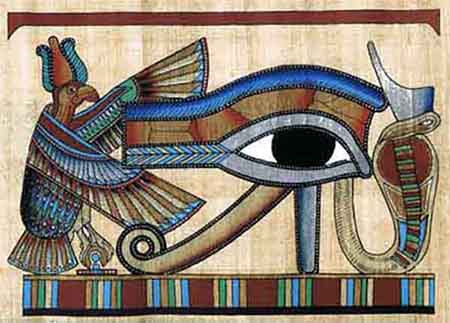
Ancient Egyptian symbol of protection and royal power from the Gods
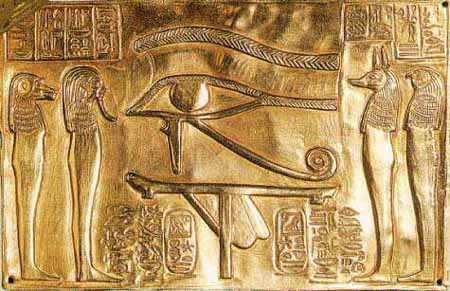
Seven different hieroglyphs are used to represent the "eye" (human body parts). One is the common usage of the verb: to do, make, or perform. The other frequently used hieroglyph is the Wedjat, a sacred eye symbol that gives a mummy the ability "to see again", called the Eye of Horus after his cult rose to prominence as the son of Hathor.
When you study the mythologies of ancient civilizations, you realize they are all designed by the same geometric blueprint that follows into humanity's current timeline. In the physical we find duality on all levels, especially in the pantheons of creational forces linked to one another. We further find the pattern of creation and destruction ... repeating in the cycles of time ... embracing the human experience. Designing the gods and goddesses falls into the same categories of duality - good and bad - light and dark - forever seeking balance and the return to full consciousness.
Always we find Gods who came from the sky (higher frequency) and those that came from the sea of creation (collective unconsciousness). Their creation myths speak to us about a beginning and an end for Earth, giving rise to something greater. We are reaching the end of the current programmed experience. Reality is a holographic projection seen through the eye of consciousness in time. The eye is a metaphor for the place of creation through which all things emerge as consciousness and are experienced and archived as it moves to the next.
The Egyptian Pantheons of major and minor gods and goddesses follow the pattern along with animal representations that link to destruction and rebirth - birds, cats, aquatic beings who create or destroy. In truth, one soul played the roles of all the gods. That souls also played the god roles in all of the ancient civilizations as told in their creation myths.
Who they are and what they symbolize are all part of the myth, math, metaphor and magic of realities.
Horus is linked with the eye of time (Hours). He is also part of the ancient mystery school teachings - sometimes referred to as the Right Eye of Horus Mystery Schools which hold the truth about reality. These teachings were allegedly encoded by Isis and Osiris - left behind with their priests in Egypt to be passed down through the millennia until the time was right for consciousness to awaken. Many believe these are the same souls who were the priests in Atlantis. The Eye of Horus and the Eye of Ra or God are one and the same.
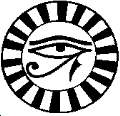
36 around 1
Time and Synchronicity
Pyramids Above and Below create the hourglass
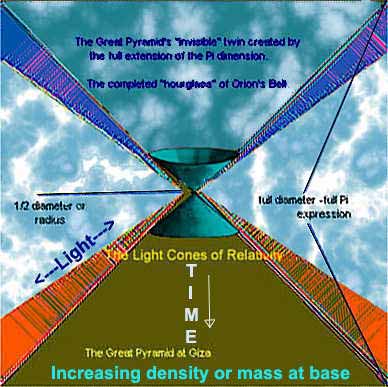
Thoth Thought Consciousness
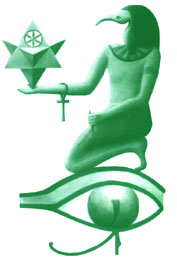
Thoth and Horus are the same soul - bird headed gods - metaphors for 'flight'
spiraling evolution of consciousness through the alchemy of time.
